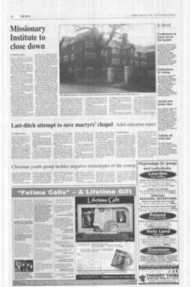Page 16, 24th February 2006
Page 16

Report an error
Noticed an error on this page?If you've noticed an error in this article please click here to report it.
Tags
Share
Related articles
Shrines To The Sacraments
Fish, Flesh And Fowl All Immortalised In Stained Glass
Sculpturedglass
Stained Glass —an Irish Artist's Designs
Art Of Light: German Renaissance Stained Glass
A glittering testament to the Real Presence
Sikersmithing and stained glass are independent disciplines but they become complementary in a religious context, and nowhere shows this more convincingly thansthe new sacred silver and stained glass galleries at the Victoria and Albert Museum. It is the first time that both have been combined. They are among the most beautiful and stimulating developments that are currently taking place in the museum.
New galleries devoted to silver, paintings, sculpture, architecture, prints and drawings and portrait miniatures have already opened. There is more to look forward to. This month the Dorothy and Michael Hintze Sculpture Galleries open and in July the Jameel Gallery of Islamic Art, In 2008 comes the William and Judith Bollinger Jewellery Gallery, and in the following year the redevelopment of the museum culminates in the £30m medieval and renaissance wing.
What marks these events is a new, contextual approach to museum display that enables the objects on exhibition to make better sense to the visitor. 'I'his is in contrast to the past, when they were presented as examples of different media and, in the primary galleries, chosen thematically on the principles of excellence and connoisseurship. I liked the old approach because it stimulated a desire for knowledge. These days the public expects to be spoon-fed; in the case of religious artefacts this is necessary, so wide is the chasm between religion and secular society.
Christianity has been the dominant religion in the Western world for 1,600 years and from the beginning. the Eucharist has, until the Reformation, occupied the centre of Christian worship. These factors detemiine the presentation and themes of the gallery's contents. Everything is seen in the framework of worship: Eastern and Western. Catholic and Protestant, Anglican and Nonconformist. Combined with an evolutionary interpretation, the development of craft and style is considered within the setting of period. At the start is a small display of silversmiths' tools that demonstrate the constant factors of
technique. Long and tall, the gallery is visually sophisticated and dramatic in effect. Designed by John Ronayne, the cases are beautifully lit and make the silver look pristine, gleaming with white light reflected in the surfaces, while the stained glass is mounted in a series of black metal screens set against a range of windows looking on to the garden, designed by the jeweller Wendy Ramshaw.
Every aspect of Christian worship and devotion is represented and there are cases of magnificent Jewish plate, including a 17th-century Dutch Torah mantle and Italian silver filigree rimmonim. For those of us in the West, the case devoted to the Eastern Churches contains surprises that range from the purity of design of Ethiopian church silver to the elaborate work of the Armenian, Greek and Russian Orthodox traditions. In stark contrast, the Nonconformist plate includes a simple travelling communion set composed of small beakers and Methodist china and glass loving cups.
Much will interest British Catholics. A case devoted to secret Catholicism has recusant church plate, a simple chalice that unscrews into three pieces to avoid detection, embossed sanctuary lamps from private chapels, oil stocks, a wonderfully pure reliquary cross made for a relic of the true cross by Benjamin Pyne in 1716. Then there is the sumptuous altar plate from the Sardinian Embassy Chapel in Lincoln's Inn Fields, made in Turin by the goldsmiths Lorenzo Lavy and Carlo Micha in the 1750s and saved from the Gordon Riots.
Private devotion, medieval and Baroque, includes shrines like a Sicilian plaque of St Rosalia of silver and coral made in Tropam in 1650, reliquary pendants of silver-gilt and enamel, and small images. At one end of the gallery is an electrotype replica of the medieval silver-gilt shrine of St Simeon at Zadar, in Croatia, that stands above a case of large reliquaries, including one of St Januarius in the form of his head with a flowing beard turned into supports.
My favourite cases are those devoted to the Spanish processional crosses designed to be carried in vast churches, and Counter-Reformation plate, heavily jewelled and chased, that triumphantly proclaims belief in the Real Presence and the Communion of Saints. And the same intensity of conviction is found in Gothic Revival plate, heralded by the experiments of Pugin, while the dignified Anglican flagons and large chalices represent a different understanding of Eucharistic doctrine.
But no greater contrast could be found than in the mean communion beakers of pewter and copper that mark the Protestantism of the reign of King Edward VI and the denial of transubstantiation. The action and reaction of successive religious movements is powerfully conveyed by workmanship that outwardly expresses Christian belief.
Exquisite though much of the stained glass is, it unavoidably plays second place to the silver. The brilliantly lit cases compete with the natural light essential for stained glass. Approximately 150 pieces of glass are exhibited, including Gothic panels from Canterbury Cathedral, St Denis and the Sainte-Chapelle in Paris, through to the Gothic Revival, culminating in 20th-century glass that demonstrates a bias in favour of the Arts and Crafts Movement. The craft is well charted and will please the general public as much as the specialist.
The sacred silver and stained glass galleries are a triumph and deserve success; they inform as well as delight the eye. Why not combine a Sunday visit with Solemn Mass at the Oratory where you will find sacred silver, fine vestments and good music still in use to the greater glory of God? No better path to understanding could be found.
blog comments powered by Disqus

















